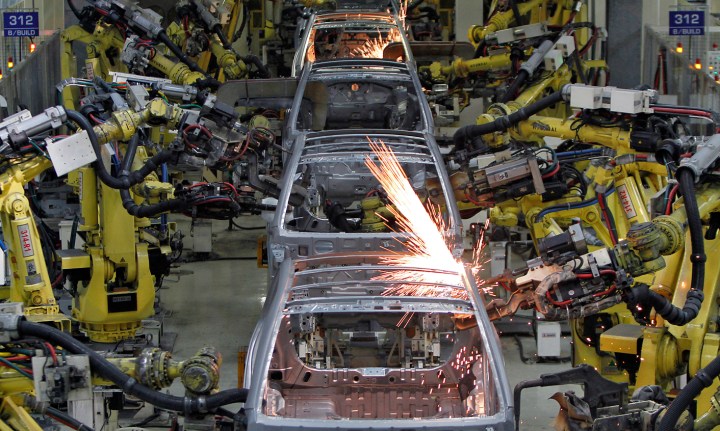World
Indian economy: Up, up and up?

It’s said that growth for the sake of growth is the ideology of the cancer cell. And yet even the slightest dip in growth in the “Champion’s League” of the world’s economy, the Brics club, sets alarms off. For months now, experts have warned of a gradual implosion underway in the Indian economy. The Indian government, however, begs to differ. By KHADIJA PATEL.
There were poppadums and garlic naan. Rice and curries. Drinks and ice cream. Diplomats and journalists. At the invitation of the Indian High Commission, a group of journalists convened at The Raj restaurant in Sandton. Journalists rarely miss an opportunity for free food, but sadly for them, there really is no such thing as a free lunch. And as an Indian descendant myself, I know too well that Indians never – ever – give away something without the hope for something in return. (Just ask our president.)
Staying true to this rich tradition, then, the Indian High Commission offered journalists a splendid lunch in exchange for an explanation on the state of the Indian economy.
But even before starters could be served, High Commissioner Virendra Gupta sought to dispel the notion of an Indian economy in grave danger. His was a vigorous rebuttal: The Indian economy was not in trouble, he maintained, and more than that, the great Indian economic miracle was alive and kicking. Gupta had actually convened the briefing to react to reports he’d read in the South African press that took a decidedly negative view of the state of the Indian economy. It’s all a big misunderstanding, he argued. And he came ready with a lesson in the evolution of the Indian economy and the relevant statistics to apply a rosier tint to the economic gloom we’ve been reading about.
In August, The Economist spelled out the prevailing opinion on the condition of the Indian economy after Indian GDP figures defied expectations of imminent doom. First up, economic figures are unreliable and even if they are correct, there are problems plaguing India far beyond the vagaries of currency depreciation, astronomical inflation, foreign direct investment, fiscal deficits and all those other fancy-sounding terms the statistically inclined throw around.
“Then there is the central problem of capital investment. It fuelled the boom between 2004 and 2008 and also raised the economy’s potential. But the private sector is still on strike and refusing to put money in the ground. That partly reflects interest rates and the global slowdown. But it mainly reflects the disaster-zone that is India’s politics and bureaucracy right now, with endemic corruption, indecision and red tape.
“Are the GDP figures better news? Yes. They give weight to the idea the economy can bumble along at 5 – 6%. Are they evidence that India’s economy is on the mend? Sadly, not.”
“The alarm bells,” Gupta insists, “are somewhat misplaced.”
The growth rate achieved by India last year, 6.5% – with a rate of 5,5 -6 % projected for this year – was described by Gupta as “spectacular” in the context of the global financial crisis.
The Economist’s take on Indian growth invites a reminder of Reg Rumney’s takedown of the magazine’s controversial assessment of the state of South Africa. He said if The Economist’s approach to South Africa was applied to the UK, it would say:
“It has made progress since it stopped being an imperialist exploiter in the 1960s. But a failure of leadership means that in many ways, Britain is now going backwards. Unemployment, economy at zero growth or worse, increasing xenophobia, youth riots, a troubled coalition government running an unpopular austerity, house prices that make home ownership impossible for new entrants, an ageing population that puts a strain on the fiscus etc, spell bad news for the green and pleasant isle.”
Gupta said the first rumblings of a crisis in the Indian economy emerged after ratings agency Moody’s warned of a downgrade for India. Ratings agencies like Moody’s, Gupta argued, had “their own reasons, which are not always transparent”. He argued ratings agencies and the business press unfairly targeted developing countries.
Professor Dilip Menon, the Mellon Chair of Indian Studies and the Director of the Centre for Indian Studies in Africa at the University of Witwatersrand, said: “The Indian economy is doing badly only within the neoliberal paradigm that the Financial Times and The Economist subscribe to.”
If you leave aside the neoliberal paradigm, then the Indian economy is doing well. He relates the example of the “former untouchable” castes, now known as the “Dalits”, who – studies show – have also profited from the economic boom, greatly enriching some through industry in north and south India. “This is through the process of liberalisation of the Indian economy,” Menon said.
That process of liberalisation that has opened up the Indian economy to the world, a development High Commissioner Gupta said was “irreversible”. Loosening controls on imports and exports, he said, had triggered the rate of production that birthed the great Indian economic miracle.
While the Indian government is optimistic that a 5.5 – 6% GDP rate of growth can occur this year, and hopeful too of a return to 7% growth for 2013, the International Monetary Fund (IMF) has been far less positive. The IMF predicts Indian growth will drop to 4.9% this year. Experts point out that even if the government’s prediction is met, 2012 is set to register the lowest rate of Indian GDP expansion for years, excluding the 2008 crisis year, for more than a decade.
But of course all these figures belie the reality of a massively unequal India. An India with two faces – the public face of modern India with all its supersized malls, IT villages and slew of housing developments has trumped the other face, the India of shanty towns, crippling poverty and chronic unemployment.
“We are not concerned that our growth rate has dropped,” Gupta argued. “We want to grow inclusively.” He said economic growth for the Indian government was pinned to poverty eradication and an expansion of basic service delivery.
“If you look at the Indian economy from below, there is a considerable economic transformation. More and more people are moving out of social and economic backwardness into a space where they can actually engage with the economy.”
Menon credits this to the opening up of the Indian economy as well as “a massive churning of the social classes”, a churning he says has been absent from South Africa.
To Gupta’s credit, he did not hide India’s socio-economic strife beneath the bluster of the statistics. He acknowledged on multiple occasions the responsibility of the Indian government to better serve the country’s marginalised.
Menon pointed out child malnutrition, poverty, sanitation and other basic services remained a harsh reality for a great many Indians. He said, “We also have to recognise that there are these points of growth, development and hope that are happening.”
The rub, however, lies in whether economic growth alone can actually eradicate poverty, bridge inequality and just make India (and the world) a better place. Is it really possible for India, or anybody else to end poverty by spending our way through it? That is the other chicken and egg question.
Lest we forget, as well, the fortunes of friends and allies like the Indians are intricately connected to our own financial health and economic stability. Gupta revealed India was actually the greatest buyer of South African gold and India’s energy production is also dependent on South African coal. Interestingly, Gupta was unperturbed by the risk to India’s imports of South African commodities by unrest in the mining sector.
“Every country goes through crises,” he said.
South Africa certainly does, and India too. Except the government there has been astute enough to offer the doubters a little something more to chew on. DM
Photo: Robot arms assemble cars inside the Hyundai Motor India Ltd. plant at Kancheepuram district in the southern Indian state of Tamil Nadu October 4, 2012. REUTERS/Babu



















 Become an Insider
Become an Insider